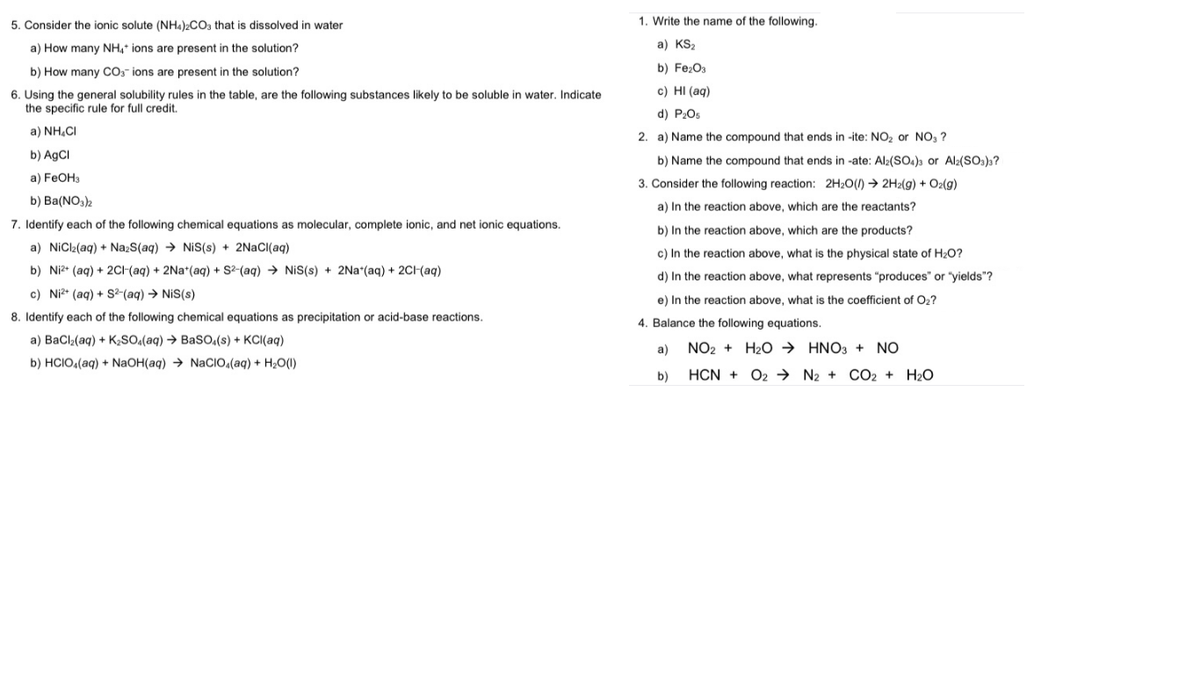5. Consider the ionic solute (NH4)2CO3 that is dissolved in water 1. Write the name of the following. a) How many NH, ions are present in the solution? a) KS2 b) How many CO,- ions are present in the solution? b) Fe2O3 с) HI (аg) 6. Using the general solubility rules in the table, are the following substances likely to be soluble in water. Indicate the specific rule for full credit. d) P2O5 a) NH,CI 2. a) Name the compound that ends in -ite: NO, or NO, ? b) AgCI b) Name the compound that ends in -ate: Al2(SO4)3 or Al2(SOs)a? a) FEOH3 3. Consider the following reaction: 2H20(1) → 2H2(g) + O2(g) b) Ba(NO3)2 a) In the reaction above, which are the reactants? 7. Identify each of the following chemical equations as molecular, complete ionic, and net ionic equations. b) In the reaction above, which are the products? a) NiCl2(aq) + NazS(aq) → NiS(s) + 2NACI(aq) c) In the reaction above, what is the physical state of H2O? b) Ni2* (aq) + 2CI(aq) + 2Na*(aq) + S2-(aq) → NiS(s) + 2Na*(aq) + 2CH(aq) d) In the reaction above, what represents "produces" or "yields"? c) Ni?* (aq) + S²-(aq) → NiS(s) e) In the reaction above, what is the coefficient of O?? 8. Identify each of the following chemical equations as precipitation or acid-base reactions. 4. Balance the following equations. a) BaCl2(aq) + K2SO.(aq) → BaS0,(s) + KCI(aq) a) NO2 + H2O → HNO3 + NO b) HCIO,(aq) + NaOH(aq) → NaCIO,(aq) + H2O(I) b) HCN + O2 → N2 + CO2 + H2O
Electronic Effects
The effect of electrons that are located in the chemical bonds within the atoms of the molecule is termed an electronic effect. The electronic effect is also explained as the effect through which the reactivity of the compound in one portion is controlled by the electron repulsion or attraction producing in another portion of the molecule.
Drawing Resonance Forms
In organic chemistry, resonance may be a mental exercise that illustrates the delocalization of electrons inside molecules within the valence bond theory of octet bonding. It entails creating several Lewis structures that, when combined, reflect the molecule's entire electronic structure. One Lewis diagram cannot explain the bonding (lone pair, double bond, octet) elaborately. A hybrid describes a combination of possible resonance structures that represents the entire delocalization of electrons within the molecule.
Using Molecular Structure To Predict Equilibrium
Equilibrium does not always imply an equal presence of reactants and products. This signifies that the reaction reaches a point when reactant and product quantities remain constant as the rate of forward and backward reaction is the same. Molecular structures of various compounds can help in predicting equilibrium.
SOlve this

Trending now
This is a popular solution!
Step by step
Solved in 2 steps









